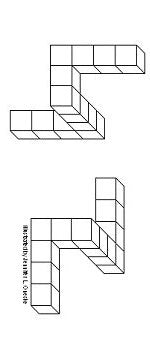it turns out that playing with wooden or other blocks in early childhood can be directly linked to STEM skills in later life – and so, is most important for STEM skills and 21st century learning.
spatial intelligence, or visuo-spatial ability, has been defined as the "ability to generate, retain, retrieve, and transform well-structured visual images" (lohman 1996)
it’s what happens when we imagine shapes and turn and twist them in our mind’s eye. it’s the skill we use to visualise the route home, fit bags into the boot of a car or when we figure out how to use a map to navigate.
here is a classic spatial reasoning test is this – are the shapes below different? or are they just oriented differently? (message us for the answer ;)

although spatial skills are only one of the multiple intelligences, and thus only part of someone’s overall cognitive abilities, there have been numerous studies pointing to how important they really are.
the importance of spatial skills:
- studies indicated that pre-schoolers who were better at visualising spatial relationships had a stronger grasp of mathematics later in school (zhang 2014, gillian 2017, verdine 2014)
- the same sort of ability continued in middle and high school as a stronger grasp of science and STEM subjects (ganley 2014; clements 2015)
- and spatial ability has even been linked to career success in STEM related fields (kell 2013, wai 2009)
so clearly spatial skills are important, and given their impact on the grasp of STEM subjects and career success in STEM fields, they’re going to be important in the foreseeable future as well.
spatial reasoning is trainable
the good news is that spatial skills can be developed.
although some part of spatial reasoning is inherited (multiple intelligences), and even ode to gender (boys have been found to display stronger spatial abilities than girls of the same age, it has been found that spatial reasoning is trainable, both for adults and (more effectively) for kids.
and training spatial skills is simple, convenient and FUN!
as listed by the johns hopkins centre for talented youth, spatial skills are trainable in a few simple, convenient and most importantly, fun, ways.
- spatial language – parents who use more spatial language, such as on, behind, up, down, bigger, taller, under, around etc. – had a positive impact on their children’s spatial abilities. it was just a matter of reframing language from “stand here” to “stand next to the sofa” or from “get me an apple” to “get me an apple from on top of the fridge”
- through gestures – parents could supplement their use of spatial language with gestures to demonstrate things like “around”, or “taller” or “the top” etc. doing this created a stronger link between the concept and what it meant in the physical world.
- and the most important one – through playing with wooden (or other) blocks -it was found that kids who played more with blocks demonstrated stronger spatial abilities. as they played, they explored the shape, looked at it from different angles and used it in a variety of ways in their play, in some ways really developing mastery over the shape. it wasn’t only wooden blocks that were good – although these were conducive to the widest variety of play - and – but lego, 2 dimensional block play or even folding paper into different shapes – similarly boosted spatial skills. these spatial abilities could be further enhanced by more structured block play like asking children to replicate a given structure.
so integrate spatial reasoning at home in your language, with your gestures and in the playscapes you make for your children. the future architect, engineer or 3D modeller in them may thank you for it later :)
references:
- https://www.parentingscience.com/spatial-intelligence.html
- https://www.youtube.com/watch?v=72jpehXhIPU
- https://en.wikipedia.org/wiki/Toy_block
- https://www.sciencedaily.com/releases/2018/02/180205141118.htm




Leave a comment